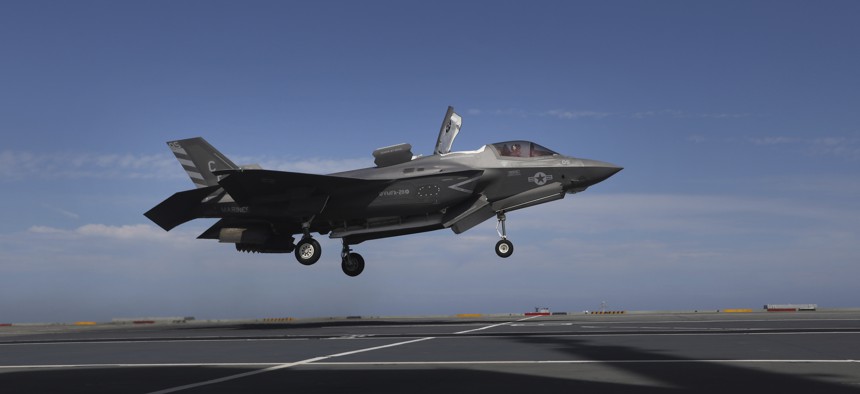Pentagon Releases Cloud Strategy for Operations Outside U.S.

A pilot maneuvers an F-35 jet as military personnel participate in the NATO Steadfast Defender 2021 exercise on the aircraft carrier HMS Queen Elizabeth off the coast of Portugal, Thursday, May 27, 2021. Ana Brigida/AP
The strategy emphasizes the need to deploy software quickly and securely to the tactical edge.
The Defense Department published a new cloud strategy for the outside the continental United States, or OCONUS, environment, that emphasizes creating advantages for all-domain operations.
The strategy, announced via the CIO’s Twitter account last week, emphasizes a need for innovative technologies and software that securely works at the tactical edge, even when the environment lacks quality—or any—connectivity. Experts told Nextgov that despite its brevity, the strategy orients DOD in the right direction, particularly as it pertains to software.
“[The strategy] goes to great lengths to highlight the key role that software plays in DOD weapon systems and mission capabilities,” Chris Hughes, a consultant who has worked extensively on DOD cloud, told Nextgov in an email. “The strategy commits to the need for continued innovation through Infrastructure-as-Code (IaC), Continuous Integration/Continuous Delivery (CI/CD) and DevSecOps to deliver innovation securely at the speed of relevance to keep up with adversaries.”
Hughes called the strategy “long overdue” but “much needed” as DOD continues to mature its cloud capabilities. The Pentagon released its overarching cloud strategy in 2018. The strategy articulates the criticality of bringing cloud and cloud-enabled capabilities like artificial intelligence and machine learning to tactical environments despite their unique impediments, Hughes added.
Robert Slaughter, former director of the Air Force’s Platform One program, in an interview with Nextgov described the software emphasis as “awesome to see.” The strategy called the ability to deploy software to aircraft in-flight “critical” and also declared that “fighting and winning on the next battlefield will be dependent on the Department's proficiency in the rapid acquisition, integration, testing, and deployment of new software and cloud computing capabilities.”
“From a future-based standpoint, there's a massive advantage for real-time software updates,” Slaughter said. “But also from a cyber perspective, if there is a known vulnerability that is exploited on one aircraft or one weapon system, an adversary then taking that same exploit and jumping from weapon system, to weapon system, to weapon system is quite terrifying.”
Slaughter said he doesn’t see this problem as limited to the Air Force or aircraft, but rather, the entire Joint All-Domain Command and Control concept the Pentagon is working on to drive joint warfighting is dependent on the ability to do real-time software updates.
Both Hughes and Slaughter also pointed to the strategy’s mandate that cybersecurity solutions must include zero trust principles as important. DOD has emphasized over the last year in particular the need to move toward zero trust and recently released its first zero-trust reference architecture. But as always, implementation matters—especially for warfighters in contested environments.
“If not done properly, you're going to end up with very, very frustrated, operational users because they can't access the tools that they need to do their jobs,” Slaughter said. “And if they can't access it easily, if it's not a smooth experience, then they're going to actually be less capable.”
Overall, the strategy is aiming to achieve three outcomes: all-domain advantage, information advantage for warfighters, and continuous innovation of capabilities. It also enumerates three goals, each with numerous objectives: provide robust and resilient connectivity to the tactical edge, provide computing power that enables forces at the tactical edge, and deploy talent at the point of need.
With still no word on what the Pentagon intends to do with the stalled Joint Enterprise Defense Infrastrastructure cloud contract, the strategy calls for an enterprise cloud computing construct for OCONUS that facilitates agile software development, collaboration, and artificial intelligence and machine learning. Slaughter said he thinks this objective can be advanced even without JEDI with some creative use of existing authorities and resources.
“There's plenty of OCONUS dollars, I just don't think people are necessarily being creative … There's nothing that JEDI can do that's preventing us from doing those same things today.”
As far as the next steps, the DOD CIO and the Joint Chiefs of Staff will develop an enterprise OCONUS cloud architecture, according to the strategy. The architecture will build off the strategy and guide investments as well as technical implementation decisions.






